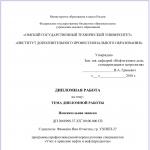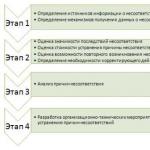In total, Resolution No. 7 approved 14 forms of primary documents, including the Invoice for the internal movement of fixed assets (Form No. OS-2).
According to the Instructions for the use and completion of primary accounting documentation forms for accounting for fixed assets, form N OS-2 is used to register and record the movement of fixed assets within an organization from one structural unit (workshop, department, site, etc.) to another.
The invoice is issued by the structural unit that transfers the fixed asset, that is, it is the deliverer. Three copies of the invoice are drawn up: the first copy is transferred to the accounting department of the organization, the second copy remains with the person responsible for the safety of the fixed assets of the delivery unit, and the third copy is intended for the unit receiving the fixed asset. Each of the three copies must be signed by the responsible persons of the delivering unit and the receiving unit.
The unit of accounting for fixed assets, as you know, is an inventory item.
Form OS-2. Invoice for internal movement of fixed assets
In accordance with clause 11 of Methodological Instructions N 91n, each inventory item is assigned a corresponding inventory number. During the period that the fixed asset is in the organization, the inventory number assigned to the object is retained.
When fixed assets are received by the organization, each inventory item opens inventory card(book). The basis for filling out the card is, in particular, acts of acceptance and transfer of fixed assets (forms N N OS-1, OS-1a, OS-1b).
The movement of fixed assets within the organization is also reflected in the inventory card (book) for accounting for fixed assets (forms N N OS-6, OS-6a, OS-6b).
In the inventory card for recording a fixed asset object (Form N OS-6), internal movement is reflected in section. 4 "Information on acceptance, internal movements, disposal (write-off) of fixed assets." In the tabular part of Sect. 4 indicates the date and number of the document on the basis of which the entry is made, the type of transaction, the name of the structural unit, the residual value of the object, as well as the surname and initials of the person responsible for storage.
So, let's look at the order in which the Invoice for the internal movement of fixed assets should be filled out (Form N OS-2).
The invoice indicates the OKUD form code. According to the All-Russian Classifier of Management Documentation OK 011-93, approved by Decree of the State Standard of the Russian Federation of December 30, 1993 N 299, form N OS-2 corresponds to code 0306032.
Then the name of the organization, its OKPO code assigned by the territorial body of state statistics, as well as the name of the structural unit-deliver and recipient are indicated.
Please note that the Procedure for the use of unified forms of primary accounting documentation, approved by Resolution of the State Statistics Committee of Russia dated March 24, 1999 N 20, determines that all details of the unified forms must remain unchanged (including codes). Removing individual details from unified forms is not allowed.
Next, you should indicate the document number and the date of its preparation. Documents must be numbered in chronological order and numbers must not be repeated during the reporting year. If an organization keeps records using computer technology, then a number is assigned to the document when it is compiled, which avoids repetition. If an organization has a large number of divisions, it is possible to provide for the numbering of documents separately for each such division. In this case, all departments should be assigned a digital or letter code, which will be indicated in the document.
According to paragraph 4 of Art. 9 of the Law “On Accounting”, the primary accounting document must be drawn up at the time of the transaction. If this is not possible, then the document is drawn up immediately after its completion. Persons drawing up and signing primary documents must ensure timely and high-quality execution of documents, the reliability of the data contained in the documents, as well as their transfer within the established time frame to the accounting department to reflect transactions in accounting.
After filling out the details already mentioned, you can begin filling out the tabular form of the invoice. It indicates the name of the transferred fixed asset object, the date of its acquisition (year of manufacture, construction), as well as the inventory number assigned to the object. The number of objects being transferred, the unit cost and the total cost are also indicated.
In the case of simultaneous transfer of several names of fixed asset objects, information about each object is entered in a separate line indicating its number.
In the unfilled terms of the invoice, dashes should be added.
On the reverse side of Form N OS-2, in the “Note” section, a brief description of the technical condition of the fixed asset object is indicated, as well as the positions and personnel numbers of the persons handing over and accepting the valuables. It also contains transcripts of the signatures of these persons indicating the date of signing the document.
The chief accountant makes a note that the movement of the fixed asset item is noted in the inventory card (book).
So, the invoice must be properly executed, that is, all the necessary details must be filled out in the document and the document must have the appropriate signatures, as established by clause 7 of Methodological Instructions No. 91n.
Note! According to clause 82 of Methodological Instructions No. 91n, the movement of a fixed asset item between structural divisions of an organization is not recognized as a disposal of a fixed asset item.
The organization's costs associated with moving an object within the organization, that is, transportation and other costs, according to clause 74 of Methodological Instructions N 91n are included in production costs (selling costs).
It is necessary to recall that assets in respect of which the conditions provided for in clause 4 of PBU 6/01 are met, and with a value within the limit established by the organization’s accounting policy, but not more than 20,000 rubles. per unit, can be reflected in accounting and reporting as part of inventories. To ensure the safety of these objects, the organization should organize control over the movement of such objects.
In Letter of the Ministry of Finance of Russia dated May 30, 2006 N 03-03-04/4/98 it is noted that if an organization decides to account for such objects as part of inventories, it must maintain appropriate accounting cards for them - a receipt order in the form N M-4, demand invoice in form N M-11, materials accounting card in form N M-17 and other primary documents. These forms of primary accounting documents were approved by Resolution of the State Statistics Committee of Russia dated October 30, 1997 N 71a “On approval of unified forms of primary accounting documentation for accounting for labor and its payment, fixed assets and intangible assets, materials, low-value and wear-and-tear items, work in capital construction” .
A few words should be said about how the transfer of property from one division to another is reflected in the accounting records of an organization. In addition to the fact that an organization can have various workshops, departments, sites, production and other divisions in its structure, it can also have representative offices and branches.
Representation according to Art. 55 of the Civil Code of the Russian Federation (hereinafter referred to as the Civil Code of the Russian Federation) is a separate division of a legal entity located outside its location, which represents the interests of the legal entity and protects them. A branch is a separate division of a legal entity located outside its location and performing all or part of its functions, including the functions of a representative office.
Clause 3 of Art. 55 of the Civil Code of the Russian Federation establishes that representative offices and branches are not legal entities and are vested with property by the legal entity that created them.
Accounting in an organization that transfers fixed assets to its branches will depend on whether or not the branch is allocated to a separate balance sheet.
If the branch is not allocated to a separate balance sheet, then the operations carried out by the branch, as well as its property and liabilities, are accounted for by the main organization in the corresponding sub-accounts opened to the accounting accounts.
According to the Chart of Accounts for accounting financial and economic activities of organizations and the Instructions for its application, approved by Order of the Ministry of Finance of Russia dated October 31, 2000 N 94n (hereinafter referred to as the Chart of Accounts), an account is intended to summarize information on the availability and movement of fixed assets in an organization 01 "Fixed assets". On account 01 “Fixed assets”, analytical accounting should be maintained for individual inventory items, while the construction of analytical accounting should provide the ability to obtain data on the availability and movement of fixed assets necessary for the preparation of financial statements (by type, location, and so on).
For account 01 “Fixed Assets” you can open, for example, the following subaccounts:
01-1 "Fixed assets in the operation of the parent organization";
01-2 "Fixed assets in the operation of the branch."
Then the transfer of a fixed asset item to the branch will be reflected in the accounting record as a debit entry in account 01-2 “Fixed assets in operation of the branch” in correspondence with the credit of account 01-1 “Fixed assets in operation of the parent organization.”
The corresponding sub-accounts must be opened for the depreciation account for fixed assets (account 02 “Depreciation of fixed assets”), as well as for other accounts.
If a branch of an organization is allocated to a separate balance sheet, accounting in the main organization will be slightly different.
The chart of accounts for summarizing information on all types of settlements with branches, representative offices, divisions and other separate divisions of the organization, allocated to separate balance sheets, is account 79 “Intra-business settlements”.
It is recommended to open a subaccount 79-1 “Settlements for allocated property” for account 79 “On-farm settlements”. This sub-account takes into account the status of settlements with branches, representative offices, departments and other separate divisions of the organization, allocated to separate balance sheets, for non-current and current assets transferred to them.
The property allocated to the divisions is written off by the organization from account 01 “Fixed assets” to the debit of account 79 “Intra-business settlements”. Accordingly, the acceptance of property for registration by a separate division is reflected in the credit of account 79 “Intra-business settlements” in correspondence with the debit of account 01 “Fixed assets”.
Accounting theory
Documentation and accounting of receipt of fixed assets
- Documentation of operations for accounting of fixed assets
- Analytical accounting of OS
- Synthetic asset accounting
- Accounting for the availability and receipt of fixed assets
1. Documentation of operations for accounting of fixed assets
Incoming fixed assets are formalized by an act of acceptance and transfer of the fixed assets object (form No. OS-1) in 1 copy. In the accounting department, on the basis of the act, an OS inventory card is drawn up (form No. OS-6). Acceptance of completed work on the completion and additional equipment of the facility, carried out in the order of capital investments, is formalized by an acceptance certificate for repaired, reconstructed, modernized OS facilities (form No. OS-3).
The internal movement of fixed assets is documented by an invoice for the internal movement of the fixed assets object (f.
Internal movement of fixed assets - document flow
Operations to liquidate all fixed assets are documented in an act for decommissioning of the fixed assets object (form No. OS-4).
Synthetic accounting of the presence and movement of fixed assets is carried out on the active, balance account 01 at the original cost. Debit balance - reflects the amount of the initial cost of the enterprise’s operating assets and those in reserve and conservation. Debit turnover reflects receipts, while credit turnover reflects the disposal of objects for various reasons.
2. Analytical accounting of OS
A unit of accounting for fixed assets is a separate inventory object, which is understood as a complete device, item or set of items with all fixtures and accessories that together perform one function.
Each inventory item is assigned an inventory number, which is retained by the item for the entire time it is in operation, stock or conservation. The inventory number is attached or indicated on the item being accounted for and must be indicated in documents related to the movement of fixed assets.
Inventory numbers of retired objects can be assigned to other newly received fixed assets no earlier than 5 years after disposal.
The register of analytical accounting of fixed assets is the inventory cards for recording the object of fixed assets (form No. OS-6) - compiled in 1 copy. in the accounting department, are filled out on the basis of primary documents (OS acceptance certificate, technical passports, etc.), which are then transferred against signature to the appropriate department of the enterprise.
3. Synthetic accounting of fixed assets
Synthetic accounting of the availability and movement of fixed assets belonging to the enterprise is kept on account 01 “Fixed assets” at their original cost.
Active account, balance account, inventory account.
Debit balance - reflects the amount of the initial cost of the enterprise's own fixed assets, operating and in reserve and on conservation.
Debit turnover - reflects receipts.
Loan turnover - reflects the disposal of objects for various reasons.
Sub-accounts can be opened for synthetic account 10:
— 01.1 - own fixed assets;
— 01.2 - leased fixed assets;
— 01.5 - disposal of fixed assets.
4. Accounting for the availability and receipt of fixed assets
Receipt of fixed assets to an enterprise can occur in various ways:
— created at the enterprise itself when making long-term investments;
— patches were purchased from other organizations;
— received free of charge from legal entities and individuals;
— received from the founders in the form of a contribution to the authorized capital;
— arrived to carry out joint activities.
All costs associated with receipt and commissioning are recorded using the following entries:
1. construction, retrofitting, reconstruction:
- in the amount of actual costs Dt 08 Kt 02, 10, 70, 69, 60, 76
- for the original cost Dt 01 Kt 08.
2. purchase from a supplier:
— for the purchase price Dt 08 Kt 60;
— for the amount of VAT Dt 19 Kt 60;
3. contribution by the founders to the authorized capital of the enterprise:
— at the agreed cost Dt 08 Kt 75.1;
- at the initial cost when accepting for accounting Dt 01 Kt 08.
4. free receipt from other organizations and individuals:
— Dt 08 Kt 98.2 at current market value;
— Dt 01 Kt 08 at the original cost;
- Dt 20.25, 26, 44 Kt 02 for the amount of monthly accrued depreciation during the useful life, deferred income is written off from account 98.2 to account 91. “Other income”.
5. Receipt for joint activities:
Dt 01 Kt 08 - at the agreed price;
6. Receipt of fixed assets in trust management Dt 01 Kt 79.
Synthetic accounting for account 01 is carried out in journal order No. 13 for the credit of account 01 on the basis of acts for writing off fixed assets and acts of acceptance and transfer of fixed assets.
Low-value fixed assets worth up to 20,000 rubles. per unit inclusive can be reflected as inventories on account 10.
OS objects during operation can move between organizational units. This process may be accompanied by a change of financially responsible persons.
Consider the following example:
On January 27, 2009, it was decided to move the air conditioner (inventory number 000000002) from the Administration division of the organization to the Production Shop division and appoint a new materially responsible person for it - Ivan Ivanovich Ivanov.
In order to perform this operation, let's create a document Moving OS (OS > Move OS). In Fig. 9.55 you can see the completed document form.

Rice. 9.55. Document Moving OS
Let's look at the features of filling out its fields.
In field Organization An organization is introduced whose fixed assets need to be moved.
In field Event enter the name of the event occurring with the fixed asset. This event must be selected from the directory. If, when you open the reference book from the document window, you find it empty, you need to create a new event, and, in this case, you need this event to have the form Internal movement(Fig. 9.56). The name of the event is not particularly important.

Rice. 9.56. Filling out the Fixed Asset Events directory
In the parameter group Accounting data we must specify the division ( Production workshop or Administration) and a new financially responsible person ( Ivanov Ivan Ivanovich).
In the tabular section Fixed assets you need to specify those OS objects that are to be moved. It is filled out based on the directory Fixed assets.
After posting the document, it does not generate accounting and tax records, but makes changes to some registers (Fig. 9.57).

Rice. 9.57. Document movements OS movement across registers
Information in the register Location of OS (accounting) was made that Air conditioner was moved to the unit Manufacturing facility under financial liability Ivanov Ivan Ivanovich.
In the information register OS Events organizations made a record of the fact of internal movement of an OS object.
I think here you might have noticed that the fixed asset was moved from a division for which depreciation on fixed assets is charged to account 26, to a division for which expenses are recorded on account 20. This means that our work on moving the fixed asset is not yet completed - you need to tell the system how to allocate depreciation in a new way. To do this you need to use the document ( OS > Depreciation parameters > Changing the method of reflecting expenses for asset depreciation), rice. 9.58.

Rice. 9.58. Document Changing the method of reflecting expenses for depreciation of fixed assets
In field Event The basis for changing depreciation must be indicated. It is filled out from a directory already known to you Events with fixed assets(type of event - Other).
Field Way should be completed indicating the depreciation method that should now be applied to the fixed asset.
To a table field Fixed assets We enter a list of fixed assets for which we want to change the way in which depreciation expenses are reflected.
After execution, the document generates records in the following registers (Fig. 9.59).

Rice. 9.59. Result of the document: Changing the method of reflecting expenses for depreciation of fixed assets
In the information register Methods of reflecting expenses for depreciation of fixed assets (accounting) a record is made of the new method used for the OS object.
In the information register Methods of reflecting expenses for depreciation of fixed assets (tax accounting) a record is also made of the new method of recording expenses.
In the information register OS events of organizations A record is made of the event that led to a change in the way depreciation expenses are recorded.
Pay attention to what the information register looks like Method of reflecting expenses for depreciation of fixed assets (accounting)(rice.
Posting internal movement of fixed assets in a budget organization

Rice. 9.60. Document movements Changing the method of reflecting expenses for depreciation of fixed assets in the register Methods of reflecting expenses for depreciation of fixed assets (accounting)
Please note that for the OS object Air conditioner There are two entries in the register. The first was done when accepting an object for accounting when entering initial balances for fixed assets. The second was done using the document discussed above. When calculating depreciation at the end of May 2009, depreciation will go to account 26. But starting from January 2009, it will go to account 20.
Read also:
VI. Accounting for the movement of fixed assets (funds)
within the enterprise and their disposal
118. The movement of fixed assets (funds) within an enterprise (organization) from workshop, department to workshop, department is formalized by issuing a standard form of invoice for the internal movement of fixed assets (funds). A copy of the invoice, prepared with receipts from the recipient and the deliverer, is transferred to the accounting department of the enterprise (organization).
119. The accounting department of the enterprise (organization) notes in the corresponding inventory cards of the transferred objects the numbers of invoices that served as the basis for the transfer of fixed assets (funds) and moves these cards to the new location in the file cabinet. Corresponding entries (marks) are made in the inventory lists of objects.
Page not found
In the case of internal movement of part of fixed assets (funds) accounted for on one inventory card, the accounting department of the enterprise (organization) makes an appropriate note about this in a copy of the card, as well as in the inventory of inventory cards, and at the same time writes out additional copies of inventory cards for the transferred objects, which are placed to the card index in accordance with the new location of the transferred fixed assets (funds). The corresponding entries are made in the inventory lists of objects at their location.
121 <*>. Enterprises, associations and organizations that have not been transferred to full economic accounting and self-financing may write off buildings, structures, equipment, vehicles and other property related to fixed assets from their balance sheets before the expiration of their depreciation life in the cases when they came unusable due to accidents or natural disasters. In other cases, the property specified in this paragraph is written off from the balance sheets with the permission of ministries (departments) or other higher authorities determined by ministries (departments).
Enterprises, associations and organizations transferred to full economic accounting and self-financing can write off buildings, structures, equipment, vehicles and other property related to fixed assets from their balance sheets if they are worn out or obsolete.
122 <*>. The procedure for writing off fixed assets from the balance sheets of enterprises, associations and organizations is established by the Model Ministry of Finance of the USSR and the State Planning Committee of the USSR "On the procedure for writing off buildings, structures, machinery, equipment, vehicles and other property related to fixed assets (funds) that have fallen into disrepair" additions and changes to it<**>.
<**>Currently, there is a Standard on the procedure for writing off buildings, structures, machinery, equipment, vehicles and other property related to fixed assets (funds) that have fallen into disrepair, approved by the Ministry of Finance of the USSR and the State Planning Committee of the USSR on July 1, 1985 N 100.
123. The executed act for the liquidation of fixed assets (funds) is transferred to the accounting department of the enterprise (organization), which notes the disposal of the object in the inventory card, and also makes notes about this in the inventory of inventory cards. The corresponding entries are made in the inventory list of fixed assets (funds) at their location.
124. If several inventory items are taken into account on one card, some of which are being liquidated, the accounting department notes the disposal of the item on the card, as well as in the inventory of inventory cards and in the inventory list.
125. Liquidation of individual accessories included in a complex inventory item, i.e. its partial liquidation is formalized in the same manner as the complete liquidation of an object of fixed assets (funds).
126 <*>. Enterprises, associations and organizations that have not been transferred to full economic accounting and self-financing, the initial cost of liquidated fixed assets and expenses associated with their liquidation (demolition and dismantling of buildings and structures, dismantling of equipment, etc.), are attributed to the reduction of the authorized capital, and the amount of accrued depreciation for complete restoration for the entire period of their service and the cost of material assets received in connection with the liquidation in the assessment of possible use or sale - to increase the authorized capital.
Enterprises, associations and organizations transferred to full economic accounting and self-financing, the initial cost of written-off fixed assets is attributed to the reduction of the authorized capital, and the amount of accrued depreciation over the entire period of their service is attributed to the increase in the authorized capital.
127 <*>. Enterprises, associations and organizations that have not been transferred to full economic accounting and self-financing, losses from the liquidation of incompletely depreciated fixed assets are attributed to the results of economic activities, except for cases when decisions of the Council of Ministers of the USSR establish a different procedure.
<*>Paragraphs 121, 122,126, 127 are given as amended by the letter of the USSR Ministry of Finance dated October 12, 1987 N 195.
Losses from the liquidation of incompletely depreciated residential buildings and other fixed assets for which depreciation for full restoration is not accrued, as well as fixed assets liquidated in connection with the construction of new ones, expansion, reconstruction and technical re-equipment of existing enterprises and facilities, on the results of economic activities of enterprises , associations and organizations do not apply. For incompletely depreciated fixed assets retired due to natural disasters, as well as those sold in the prescribed manner as surplus and unused, losses are not determined. The residual value of such fixed assets is written off from balance sheets to reduce the authorized capital.
Enterprises, associations and organizations transferred to full economic accounting and self-financing, losses arising from the transfer of fixed assets to other enterprises and organizations, during their sale and write-off (in connection with the dismantling of buildings and structures, dismantling of equipment, etc.) are covered through appropriate economic stimulus funds. The composition of losses does not include the incompletely depreciated part of fixed assets.
128. In accounting, identified losses from the liquidation of incompletely depreciated fixed assets (funds) are reflected in the credit of the Charter Fund account and the debit of the Profit and Loss account under a separate item.
129. Losses from the liquidation of incompletely depreciated fixed assets (funds) listed on the balance sheet of the developer (including residential buildings) are written off in the prescribed manner and included in the inventory value of the objects. Profit from the liquidation of the specified fixed assets (funds) is added to the sources of financing the construction of facilities.
130. Productive livestock culled from the main herd and put for fattening, handed over to procurement organizations, sold externally, as well as draft cattle culled from the main herd, are written off in the manner established for the liquidation of fixed assets (funds).
<*>Clause 131 was excluded by a letter from the USSR Ministry of Finance dated
132. The transfer of fixed assets (funds) from one enterprise (organization) to another in the manner prescribed by law is formalized by an acceptance-transfer certificate of a standard form, with the exception of cases when this transfer, in accordance with current legislation, is formalized in a special order.
133. Based on the act, the accounting department of the enterprise (organization) makes an appropriate entry in the inventory card of the transferred object and attaches this card to the acceptance and transfer certificate. The withdrawal of a card for a retired object is noted in the inventory of inventory cards (inventory book) and in the inventory list at the location of the object.
134. The cost of fixed assets (funds) transferred to other enterprises (organizations) in the manner prescribed by law free of charge is written off to reduce the authorized capital in detail: the initial cost is to reduce the authorized capital, and the amount of depreciation is to increase it.
The value of fixed assets (funds) transferred free of charge to other enterprises (organizations) is written off from the balance sheet on the basis of an acceptance and transfer certificate and a written message (advice) from the receiving organization about the posting of accepted objects.
135. When dismantling equipment, the initial costs of its installation (including the costs of installing the foundation if it is not used for its intended purpose) are written off as a reduction in the authorized capital.
136 <*>. When transferring dismantled equipment to another enterprise (organization) on payment terms, its initial cost minus the amount of depreciation is written off to reduce the authorized capital, and the amount of depreciation is written off to the Depreciation of fixed assets (funds) account.
Enterprises and economic organizations that are subject to the Regulations on the Socialist State Production Enterprise reflect the amount of proceeds from the sale of assets related to fixed assets, less expenses associated with their sale, on the credit of the account of the Economic Stimulus and Special Purpose Funds (according to the corresponding subaccount) and debit the account of the Authorized Fund.
In the same order, proceeds from the liquidation (by dismantling) of excess equipment, vehicles, and devices not used at the enterprise that are included in fixed assets (funds) are reflected in accounting (at the cost of the price of possible use or possible sale). In this case, losses from the liquidation of incompletely depreciated fixed assets are reflected in accounting in the generally established manner.
The costs of transportation, unloading, storage of excess equipment included in fixed assets (funds), incurred before its sale, are included in industrial enterprises, contractors and other organizations to reduce the authorized capital.
Enterprises, associations and organizations transferred to full economic accounting and self-financing, proceeds from the sale of unused fixed assets, as well as the cost of material assets received in connection with the write-off of fixed assets in the assessment of possible use or sale, are sent to the fund for the development of production, science and technology .
137. The return of the leased inventory item to the lessor is formalized by an acceptance certificate - transfer of a standard form. Based on the act, the tenant's accounting department removes the returned object from off-balance sheet accounting and removes the corresponding inventory card from the file cabinet, which, together with the act, is transferred to the archive.
138. Completed capital work on leased fixed assets (funds), transferred to the lessor in connection with the expiration of the lease term, is written off by the tenant at the original cost to reduce the authorized capital, and the amount of accrued depreciation is credited to the authorized capital account and debited to the Depreciation of fixed assets account ( funds). The lessor includes the initial cost of the work in its fixed assets (funds) with an increase in the authorized capital, and by the amount of the depreciated part of the costs of leased fixed assets, debits the authorized capital account and credits the Depreciation of fixed assets (funds) account.
The movement of fixed assets is associated with the implementation of business transactions for the receipt, internal movement and disposal of fixed assets. These operations are documented in the following forms of primary accounting documentation.
Incoming fixed assets from other institutions and organizations are accepted by a commission appointed by the head of the organization. To formalize the acceptance, the commission draws up an act of acceptance and transfer of fixed assets (f. OS-1 budget) in two copies for each object separately.
The acts indicate the name of the object, the year of construction or production by the plant, a brief description of the object, the initial cost, the inventory number assigned to the object, the place of use of the object and other information necessary for analytical accounting of fixed assets.
After registration, the acceptance and transfer certificate of fixed assets is transferred to the organization’s accounting department. They also attach technical documentation related to this object (passport, drawings, etc.).
Based on these documents, the accounting department makes appropriate entries in the inventory cards of fixed assets, after which the technical documentation is transferred to the technical or other departments of the organization.
The act is drawn up in two copies, approved by the head of the institution, organization (sender) and the head of the institution (recipient), while the first copy of the act remains in the institution accepting the fixed asset item on its balance sheet, and the second is transferred to the institution, organization (sender).
Since fixed assets are assigned to budgetary institutions with the right of operational management, issues of acceptance and transfer of these funds must be agreed upon in the manner established by current legislation with the owner of the property, on whose behalf in accordance with the Regulations on the Ministry of Property Relations of the Russian Federation, approved by a resolution of the Government of the Russian Federation dated June 3, 2002 N 377, its territorial bodies act.
Invoice for internal movement of fixed assets f. OS-2 is used when transferring fixed assets from one financially responsible person to another within an institution or with centralized accounting - from one institution to another.
The act indicates the name of the object, its inventory number, a brief description of the technical condition of the object, the recipient and the deliverer, indicating their positions and signatures, the name of the structural units (organizations) handing over and accepting the object, the signature of the accountant.
The invoice is approved by the head of the organization. If it is necessary to coordinate the transfer of an object with higher organizations, the invoice indicates the name of the ministry or other government body with the signature of the head and chief accountant and the name of the state property management body with the signature of the head.
Acceptance of completed work on the completion and additional equipment of a facility, carried out in the order of capital investments, is formalized by an acceptance certificate for repaired, reconstructed and modernized facilities (form OS-3).
The act indicates the change in the technical characteristics and initial cost of the object caused by reconstruction and modernization. The act is signed by an employee of the workshop (department) authorized to accept fixed assets, and a representative of the workshop of the organization carrying out reconstruction and modernization, and submitted to the accounting department of the organization, which makes the appropriate entries in the inventory card for accounting of fixed assets. If repairs, reconstruction and modernization are carried out by a third-party organization, the act is drawn up in two copies (one copy for both parties).
Fixed assets are issued from the warehouse according to invoices (requirements) f.
Transfer of fixed assets within the enterprise
434, which are approved by the head of the institution.
The invoice is issued in two copies by the employee of the delivery shop (department). The first copy is transferred to the accounting department for recording in the inventory card, and the second copy remains with the deliverer to mark the disposal of the corresponding object in the inventory list of fixed assets.
The invoice indicates the name of the object, its inventory number, the deliverer and recipient and other necessary information on the object transferred from the warehouse.
The disposal of fixed assets is carried out by the institution in the manner prescribed by current legislation.
To formalize the write-off of fixed assets that have become unusable, the following are used: acts on the write-off of fixed assets in budgetary institutions f. OS-4 budget; acts on the write-off of vehicles in budgetary institutions f. OS-4a budget; acts on the write-off of literature excluded from the library in budgetary institutions f. 444.
These acts are drawn up by a permanent commission appointed by order of the head of the institution.
Acts on the write-off of fixed assets indicate the technical condition and reason for the write-off of the object, the original cost, the amount of depreciation, expenses associated with the disposal of the object, the cost of material assets (spare parts, scrap metal, etc.) received from the write-off of the object (proceeds from the sale ).
The acts are signed by the chief accountant and approved by the head of the organization.
For objects, the write-off of which must be agreed upon with higher organizations, in f.
OS-4 budget. the name of the ministry or other government body and the signatures of the head and chief accountant, as well as the name of the state property management body and the signature of its head are indicated.
Dismantling and dismantling of fixed assets before the approval of acts on their write-off is not allowed.
Parts and assemblies made using precious metals, as well as parts and assemblies made from ferrous and non-ferrous metals and not used for the needs of the institution, are subject to sale to the relevant organizations that have licenses for this type of activity. Parts and assemblies written off the balance sheet and manufactured using precious metals are accounted for by the institution in accordance with the regulatory legal acts of the federal executive authorities, agreed upon with the Ministry of Finance of Russia.
The cost of materials received from the dismantling of individual fixed assets and left for the economic needs of institutions is attributed to the increase in funds for special purposes or funds generated from profit (depending on the sources of acquisition of written-off fixed assets).
Amounts received by institutions from the sale of unused equipment and other fixed assets, as well as materials received from dismantling fixed assets, remain at the disposal of the institution and are allocated, depending on the sources of acquisition of fixed assets, to increase funds for special purposes, funds generated from profits, or income of the reporting period (see § 2.5).
In case of violation of the current procedure for writing off fixed assets from the balance sheet, as well as mismanagement of material assets (destruction, burning, etc.), the persons responsible for this will be held accountable in the prescribed manner.
The transfer of buildings and structures from one subordination to another is carried out in the prescribed manner.
Accounting for operations on the disposal and movement of fixed assets is kept in the accumulative statement f. 438 (Memorial Warrant 9). Entries in the accumulation sheet are made for each document. In this case, in the “Total” column, the amount of retired and transferred material assets is recorded, which should be equal to the sum of the entries in the debit of the subaccounts. At the end of the month, the results of the subaccounts are recorded in the "Journal-Main" book.
1C: Accounting 8.2. A clear tutorial for beginners Gladky Alexey Anatolyevich
Transfer of fixed assets within the enterprise
Internal movement of fixed assets is an operation that is periodically performed in many enterprises. Its essence lies in the fact that an object of fixed assets is transferred from one division of the enterprise to another, but does not leave the enterprise.
In the 1C Accounting 8 program, such operations are formalized using the document Transfer of OS. A characteristic feature of this document is that based on the results of its implementation, accounting entries are not automatically generated (as is the case in most other configuration documents), but only changes are made to the information registers “Location of OS (accounting)” and “OS Events” organizations." To open these registers for viewing, execute the main menu command Operations? Information registers (this command is only available in full interface mode), and select the register in the window that opens.
To switch to the mode of working with documents Moving OS, select the OS? command in the main menu of the program. Move OS, or use the appropriate function bar link. In any case, the window shown in Fig. 7.8.
Rice. 7.8. Window for the list of documents for internal movement of fixed assets
In the corresponding columns of this window, for each item in the list, the document posting symbol is displayed (in Fig. 7.8 the first document is registered, and the second is not), the date of its formation, number, name of the company (within which the internal movement of fixed assets was carried out), the name of the structural division, full name of the materially responsible person, as well as the name of the user responsible for generating the document.
To create a new document, click the Add button in the toolbar, and to edit an existing one, double-click on it. The window for entering and editing a document is shown in Fig. 7.9.

Rice. 7.9. Window for editing a document for internal OS relocation
The Number and From parameters, which are located at the top of the window, are filled in and edited in the same way as when working with other configuration documents. The same applies to the Organization field, which indicates the name of the organization on whose behalf the document is being drawn up.
The Event field indicates the name of the event that occurs with a fixed asset object (or several objects, the list of which is formed in the tabular part of the window). In this case, you can specify the value Internal movement of fixed assets here (provided that such an event is available in the corresponding directory), but note that this parameter is not required to be filled out.
Then you need to indicate the name of the department to which the fixed assets are moved according to the document. The required value is selected in the Division field from the corresponding directory. Similarly, in the MOL field, the full name of the materially responsible person is indicated, who will be responsible for the fixed assets after they are moved.
ATTENTION
Please note that without filling out the Organization, Division and MOL parameters, you will not be able to post an accounting document.
The main part of the editing window is occupied by a table in which a list of transferred fixed assets is formed. To include a fixed asset object in this list, click the Add button in the toolbar or the Insert key, then in the Fixed asset field, click the selection button and select a value in the fixed assets directory window that opens. After this, the inventory number of the object will be displayed in the Inv. field. No. (inventory numbers are assigned in the directory of fixed assets).
The document generation is completed by clicking the OK button. Using the Save button, you can save the entered data without posting the document. The Close button is intended to exit this mode without saving the changes made.
After posting the document, you can view how it is reflected in the configuration registers. To do this, execute the Go to? command in the editing window. Movement of the document by registers - as a result, a window will open, which is shown in Fig. 7.10.

Rice. 7.10. Information about posting a document to registers
This report can be printed by pressing the key combination Ctrl+P or by executing the main menu command File? Seal.
From the book Accounting Theory: Lecture Notes author Daraeva Yulia AnatolevnaLECTURE No. 7. Accounting for fixed assets, inventories and property of the enterprise 1. Accounting for fixed assets In the economic activity of any enterprise, a special role belongs to fixed assets. The organization's fixed assets are diverse not only in composition,
From the book Finance and Credit author Shevchuk Denis Alexandrovich125. Planning of financial relations within an enterprise. Financial section of the business plan Financial relations of enterprises consist of four groups. These are relationships: - with other enterprises and organizations; - within an enterprise; - within associations that include
From the book Analysis of Financial Statements. Cheat sheets author Olshevskaya Natalya45. Revaluation of fixed assets The initial cost of fixed assets can be changed in the following cases: 1) carrying out capital works at the site (completion, additional equipment, reconstruction). The following entries are made: – debit
From the book All about the simplified taxation system (simplified taxation system) author Terekhin R.S.49. Depreciation and amortization of fixed assets of an enterprise Fixed assets of an enterprise serve for several years and are subject to replacement (compensation) only as they become physically or morally worn out. Depreciation of fixed assets is a partial or complete loss of fixed assets
From the book Theory of Accounting. Cheat sheets author Olshevskaya Natalya4.2.1. Acquisition, construction and production of fixed assets, as well as completion, retrofitting, reconstruction, modernization and technical re-equipment of fixed assets Fixed assets are part of the property used as means of labor for
From the book 1C: Accounting 8.2. A clear tutorial for beginners author Gladky Alexey Anatolievich34. Depreciation and amortization of fixed assets of an enterprise Fixed assets of an enterprise serve for several years and are subject to replacement (compensation) only as they become physically or morally worn out. Depreciation of fixed assets is the partial or complete loss of fixed assets
From the book Management Accounting. Cheat sheets author Zaritsky Alexander EvgenievichMovement of valuables within an enterprise Such a business operation as the internal movement of valuables occurs periodically in any enterprise. Its peculiarity lies in the fact that the values do not leave the enterprise, but only move from
From the book Typical mistakes in accounting and reporting author58. Fixed assets of the enterprise. Procedure for accounting for fixed assets Money invested in the acquisition of factors of production for the manufacture of products is called advanced capital, which assumes all the functions of the economic category
From the book Organizational Expenses: Accounting and Tax Accounting author Utkina Svetlana Anatolyevna61. Depreciation of fixed assets of an enterprise Fixed assets of an enterprise serve for several years and are subject to replacement (compensation) only as they become physically or morally worn out. Depreciation of fixed assets - partial or complete loss of fixed assets
From the book Fixed Assets. Accounting and tax accounting author Sergeeva Tatyana YurievnaExample 30. Interest on a loan received for the acquisition of fixed assets is included by the organization in the initial cost of fixed assets for tax accounting purposes. According to subparagraph. 2 p. 1 art. 265 of the Tax Code of the Russian Federation, interest on borrowed funds is non-operating
From the book 1C: Accounting 8.0. Practical tutorial author Fadeeva Elena AnatolyevnaModernization of fixed assets Both in accounting (clause 27 PBU 6/01) and in tax accounting (clause 2 of Article 257 of the Tax Code of the Russian Federation), the costs of reconstruction and modernization of a fixed asset object after their completion increase the initial cost of the object if, as a result of modernization
From the book In Search of Perfection. A book about what employees want from their employers author Lindeberg Teri AnnChapter 1. The concept of fixed assets and the tasks of their accounting. Classification of fixed assets 1.1. The concept of fixed assets The accounting procedure for fixed assets is regulated by two documents: – PBU 6/01 “Accounting for fixed assets”, approved by the Order of the Ministry of Finance of Russia dated
From the author's bookChapter 2. Types of valuation of fixed assets. The procedure for changing the valuation of fixed assets Fixed assets can be valued at initial, residual and replacement
From the author's book3.1.2. Receipt of fixed assets as a result of construction and production of fixed assets on our own. Rules for the assessment of fixed assets that are manufactured by the organization’s employees are defined: – for accounting purposes in clause 8 of PBU 6/01 –
From the author's book5.1. Receipt of fixed assets from founders and suppliers, capitalization of fixed assets and acceptance of fixed assets for accounting Let us answer the question “What do we mean by fixed assets of an enterprise?” A distinctive feature of fixed assets
From the author's bookChapter 10 What can you say about communications within the company and within your department? Building and maintaining good communication between team members is extremely important to our success. This question was very useful as it revealed areas in which
Fixed assets represent some part of the organization’s property that is used in the process of work.
They have a certain period of use, cost and other characteristics.
At an enterprise, situations may arise in which funds are moved within the organization.
Performing internal transfer of OS objects requires compliance with special rules and appropriate documentation.
The decision on the need for internal movement of fixed assets within one owner can only be made by the management of the enterprise.

Important! Funds can move between structural units, workshops, sections, etc.
In turn, the management of the department into which the funds fall has the right to distribute them within the association.
The following circumstances can be considered the main reasons for the internal movement of operating systems:
- the need for repair work, reconstruction or modernization;
- necessity transfer of fixed assets to a subsidiary(branch), for which a separate balance sheet is allocated;
- the need to transfer OS objects to another department.
How to transfer to another financially responsible person within the same owner?
 A financially responsible person is considered to be a working citizen whose professional activity involves interaction with company property.
A financially responsible person is considered to be a working citizen whose professional activity involves interaction with company property.
The employee is responsible for its safety, damage and condition, and in case of problems, he compensates the employer for the damage caused.
In order to transfer property under the responsibility of another financially responsible person, it is necessary to carry out several actions.
First of all, need to take inventory. The results of the procedure are properly documented.
During the event, the exact quantity of fixed assets and their main characteristics, including condition, are determined.
Order to change MOL.
Compiled upon completion of the inventory. The document contains information about employees, as well as fixed assets.
A note is also made on the exact date from which responsibility for the property is transferred to another employee.
Order to transfer OS to another MOL.
Please note that documentation of this nature is quite important. However, there is no standardized form for filling it out.
When issuing an order, the management of the enterprise must comply with certain rules regarding the content of the paper.
If you have a form developed by your company for creating such documents, you can use its sample.
The following information is required to be reflected:

At the end of the order there must be a signature of the chief manager of the enterprise or his deputy.
In addition, when transferring fixed assets to another financially responsible person, the latter draws up a special receipt.
It acts as agreement with the information obtained during the inventory. It also indicates that the new MOL has no claims against the commission members.
There is a corresponding section in the inventory list for registering a note.
Change of financially responsible person may be due to several factors. Among these, the following should be highlighted:
- dismissal;
- registration of long-term sick leave by the current MOL;
- going on a business trip;
- damage to property, its damage, etc.;
- other unfavorable circumstances.
What documents need to be completed for internal OS movements?
It was previously stated that the movement of OS within an organization must be accompanied by the execution of special documentation, which must be drawn up properly.
If the established rules are violated, the employer may have problems with inspection authorities.

In this case, several documents must be prepared: invoice and order.
Previously, instead of the first paper, an OS acceptance certificate was used.
At the moment it is necessary to register exactly. For this purpose you should use unified form of form OS-2.
The order can be drawn up in free form, taking into account the generally accepted rules of the company.
Also, marks about the movement of OS within the same owner are placed in the inventory books. Changes are made to section 4 of cards.
Sample order for the transfer of property from one MOL to another
 To issue an internal movement order no need to use a standardized form. It is enough to adhere to the document management rules used in the company.
To issue an internal movement order no need to use a standardized form. It is enough to adhere to the document management rules used in the company.
Available The following information must be included:
- full name of the paper;
- place and date of issue of the order;
- document's name;
- information about fixed assets transferred within the organization - quantity, cost and other characteristics;
- the name of the divisions in which the fixed assets were previously located and where they are located;
- a note about the persons responsible for the movement;
- a note about the person responsible for executing the order;
- signatures of persons who have read the order.
The chief manager of the enterprise is in charge of processing the order.. Without his signature, the document is considered invalid.
How to issue an invoice to move an asset between financially responsible persons?
An equally important document that must be drawn up when moving fixed assets within the company is the invoice. When filling it out, you should adhere to unified form - No. OS-2.
Documentation is prepared in 3 copies. The first is intended for the person responsible for the movement, the second for the party receiving fixed assets, and the third for the company’s accounting department.
At the top of the invoice information about the enterprise is displayed:
- name of company;
- information about the OS sender and receiver;
- OKUD form;
- OKPO code.
The invoice for the internal movement of fixed assets, form OS-2, is intended to document the actual movement of any fixed assets of the organization. This can be interaction between workshops, sections, departments. The main thing is that both sides of the process (receiving and receiving units) belong to the same company.
FILES
An organization may include buildings, various equipment, machines, instruments, computer equipment, inventory, various tools, livestock, etc. All this may well be transferred from one workshop or site to another.
If the useful life of different parts of one building is different, then it is worth dividing it into two independent objects and describing it separately.
Important application features
The transfer invoice is not a document confirming the gratuitous transfer. For the latter, there is , which implies the untimely presence of an object of fixed assets in the jurisdiction of the receiving unit.
Important! Form OS-2 implies temporary movement. It may be associated with repair work, temporary operation, etc.
Filling algorithm
The invoice is filled out on both sides. It consists of a header on the title side, a table of seven columns that continues on the reverse side, as well as a place for a brief description of the transferred object and signatures of the responsible persons.
In the upper right corner of the title part of the document there is a link to the Decree of the State Statistics Committee of 2003, which approved this form as mandatory. After 10 years, it became a recommendation, but its use continues.
At the top of the invoice, the OKUD and OKPO forms and the name of the company within which the movement takes place are indicated. The unit from which the object is being withdrawn is indicated first (it is called the “delivery”). The recipient department is indicated below.
Attention! The invoice must be filled out by the delivery department.
After the names of the departments, the name of the document, the date of preparation of the paper and the assigned number are written.
Below is a table with:
- number;
- a description that includes the date of manufacture (or construction), full name, inventory number;
- number of transferred objects in pieces;
- cost;
- results.
After the table, space is left to describe the object, its technical and other characteristics. When filling out, these lines cannot be left blank. 
You can mention the condition (good, excellent, satisfactory), existing defects (scuffs, chips, etc.), and describe the packaging. If warranty cards or instructions are included, these are also included.
At the end there should be signatures (deciphered) of the persons who made the delivery and acceptance. The fact that information about the movement was entered into the accounting book is confirmed by the chief accountant (or simply the accountant who carried out the data transfer).
Important! When putting signatures, mentioning the positions of persons is mandatory.
Nuances of filling
Rows in the table should not be left empty. If a document is generated electronically, then unfilled sections of the document are simply deleted. If the paper is already printed, they are crossed out. Corrections to the invoice are not recommended. But if a mistake was made, it is corrected by a longitudinal strikethrough and the inscription “Believe the corrected one.” Moreover, next to this inscription there must be signatures of all persons who are also signed at the end of the document: the chief accountant, the handing over and receiving persons.
Is it possible to change graphs?
All this data is necessary for maintaining full-fledged accounting and warehouse records in the organization. Since 2013, this form has ceased to be mandatory. It became only advisory, in accordance with the law “On Accounting” dated 06.12.2011 No. 402-FZ.
At its own discretion, the organization has the right to refuse some columns of the primary document or add new ones. However, all these changes must be documented and have good reasons.
In short, the form is widely used today because it is convenient, illustrates the maximum amount of information and does not confuse regulatory authorities when conducting inspections and audits.
How many copies will be required?
The invoice must be filled out in at least 3 identical copies. This is done so that one invoice remains with the accountant (or the employee performing his duties) for the generation of further reporting. The second paper must be kept by the employee responsible for it for a specific facility. And the third option must be provided to the receiving party as confirmation of the verified fact. Ideally, all 3 invoices have 3 signatures of employees who are financially responsible.
What documents are filled out based on
The information contained in the completed form is used to create an inventory book for accounting for fixed assets. Individual or group accounting is assumed.
Control
If during the inspection it is discovered that the object is under the jurisdiction of one division, but is registered with another, then the organization will face administrative liability in the form of a fine.
If a violation is detected for the first time and it does not lead to an understatement of taxes, then the company can get off with a fine of 5 thousand rubles.
If during the audit it is discovered that there is no invoice for the movement of fixed assets, form OS-2, and this fact will underestimate the taxes due from the organization, then less than 15 thousand rubles. There is no penalty for such a violation. Moreover, an amount of 10% of the total tax not paid for this reason may be assigned (but this amount will still not be less than 15 thousand rubles).
Sometimes a company needs to move goods or material assets from one structure to another, but even such minor movements must be kept in the documents in order not to damage the reporting.
In any case, for internal movements, a document is drawn up that serves as a guarantee that the goods have been transferred and accepted by the other party. Depending on the goods being transferred, there are different forms of invoices. Let's take a closer look at this issue.
What is internal movement?
 Internal movement is movement of certain goods or services that occurs within a single legal entity. It can be carried out between various financially responsible persons or structural divisions.
Internal movement is movement of certain goods or services that occurs within a single legal entity. It can be carried out between various financially responsible persons or structural divisions.
Goods, materials, core values, etc. can be transferred. But regardless of what exactly is transferred, it is necessary to fill out a certain unified form, which serves as reporting for warehouses and accounting. Depending on the goods there are different forms TORG-13 and OS-2. In addition, data on internal movements is entered into the documents of the organization itself.
What kind of document is this?
To track the movement of goods, materials and fixed assets within an organization, there are special invoices that must be issued during the transfer of goods. This document is proof that material assets were transferred and accepted.
After the goods have been accounted for on both sides, the invoice must be submitted to the accounting department for a full report on the movement. It is also worth noting that only financially responsible persons can sign the document.
Travel options
 Depending on what kind of goods or valuables you are transferring, there are two unified forms: TORG-13 and OS-2. So, the first is used when we are talking about ordinary goods or materials of the company. OS-2 is used when it is necessary to transfer an item of fixed assets.
Depending on what kind of goods or valuables you are transferring, there are two unified forms: TORG-13 and OS-2. So, the first is used when we are talking about ordinary goods or materials of the company. OS-2 is used when it is necessary to transfer an item of fixed assets.
In order to draw up a document for the transfer of fixed assets of a company, you will need to refer to form OS-2, the document should be drawn up in three copies. The first one will remain with the one who provides the object, and in the future it will serve to write it off from the warehouse. The second document goes to the person to whom you transferred the object - it also serves for reporting and confirmation of how much of the product was transferred and what it was. The third copy should remain with the person who entered the data in this form.
It is on it that the signatures of both parties must be on it, and later the signature of the chief accountant, as confirmation of the validity of the transaction.
The TORG-13 invoice requires two copies and a less strict form of completion. It can only be used when it comes to goods, containers and materials. It also applies when it comes to transportation by the organization’s transport. The document will be effective when transferred between any materially responsible persons (MRP) or departments:
- main and separate;
- separate divisions;
- workshops or responsible persons.
Please fill out the form in duplicate, and this is usually done by the financially responsible person for this product or warehouse, division, etc. The form serves as a guarantee that he has transferred the goods to another person. Typically, such a document is completed before the transfer or during, if any questions arise.
To see how movement between warehouses is formalized in the 1C program, see the following video:
Procedure for filling out forms
In order to fill out the TORG-13 form, you must do the following. The header requires information about the company within which the movements are made. In addition, you should also indicate the date the invoice was issued and its number.
After this, the table is filled out; its upper part is intended for data about the person who transfers the goods and the recipient. Further in the table it is worth indicating information about which goods are being transferred:
- quantity;
- unit of measurement;
- discount price - usually set within the company itself;
- total cost of transferred materials.
Then both parties should sign.
 Form OS-2 should be filled out on both sides. The front side will contain the name of the legal entity, as well as the full name of the structural units from whom the object is transferred and to whom.
Form OS-2 should be filled out on both sides. The front side will contain the name of the legal entity, as well as the full name of the structural units from whom the object is transferred and to whom.
The document must also indicate the date of transmission and the form number. After this, in the table you need to indicate the name of the transferred object, as well as:
- the date it was issued or manufactured;
- its inventory number;
- how many objects will be transferred;
- the price of these items.
Below the table you should briefly describe the condition of the funds to be transferred, their damage, if any. After all the data has been filled in, both parties must check the accuracy of the entered data. Representatives must also sign, indicating their full name and position in the organization. After this, the document must be checked by an accountant and signed at the very bottom.




















